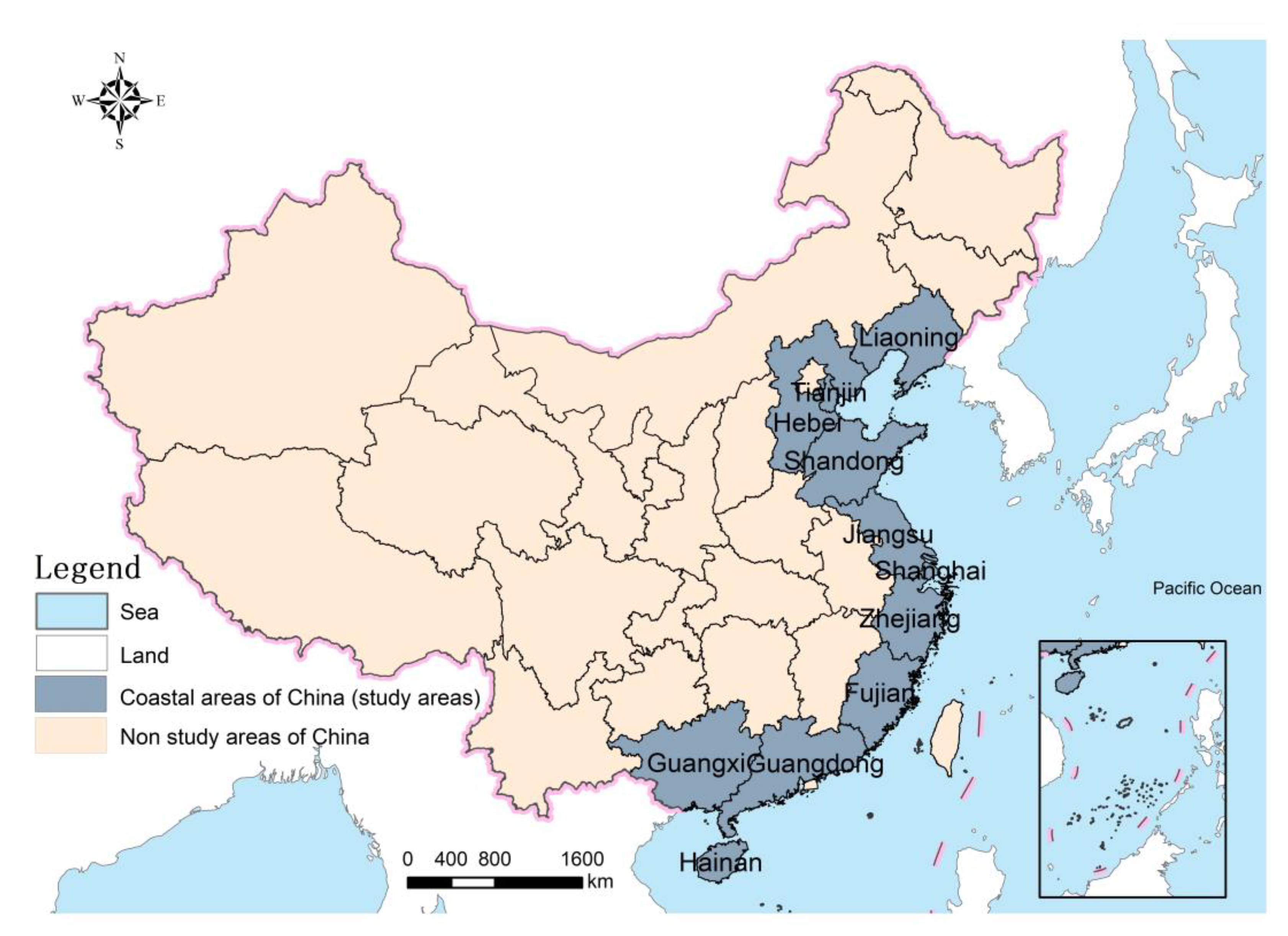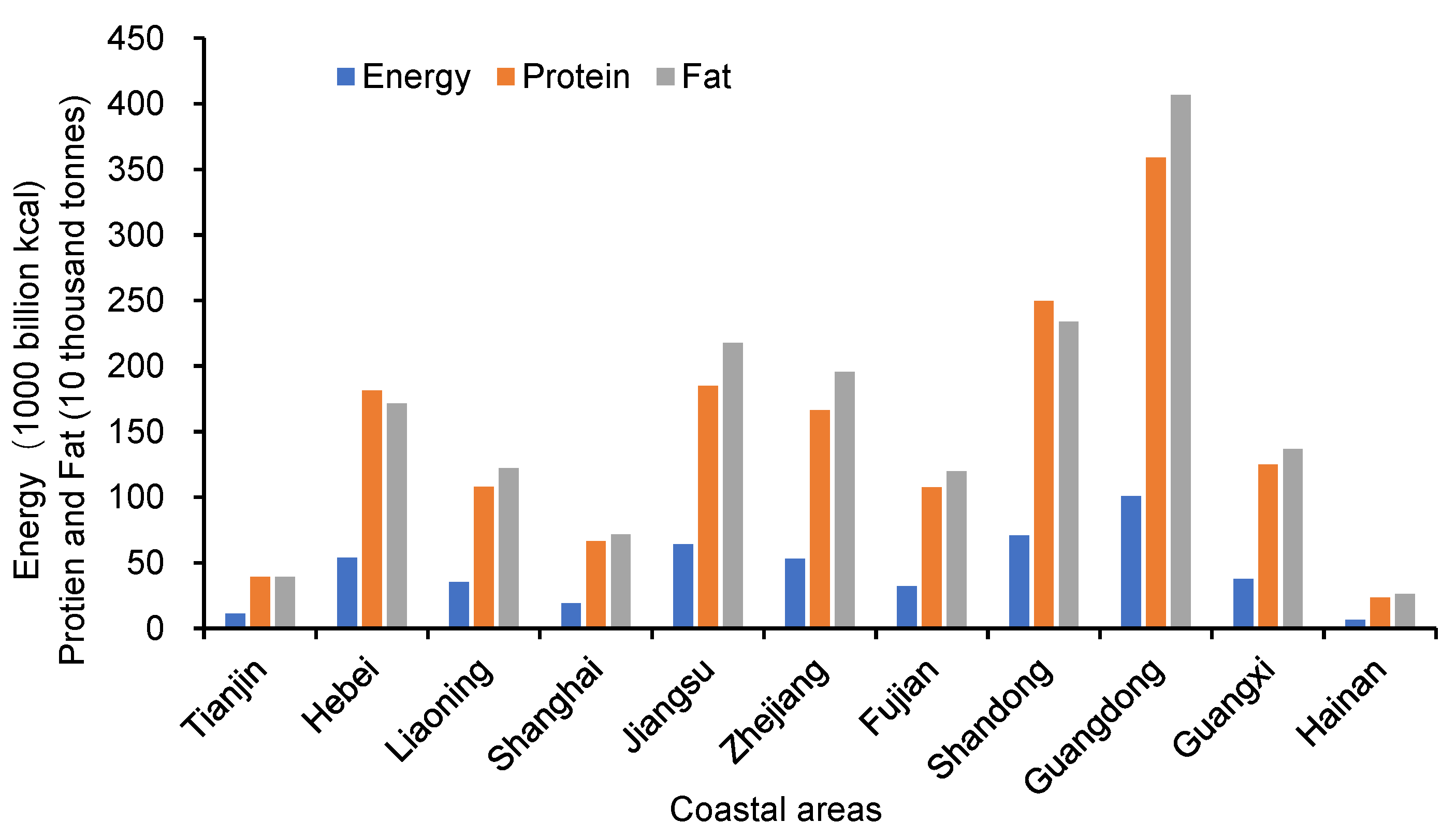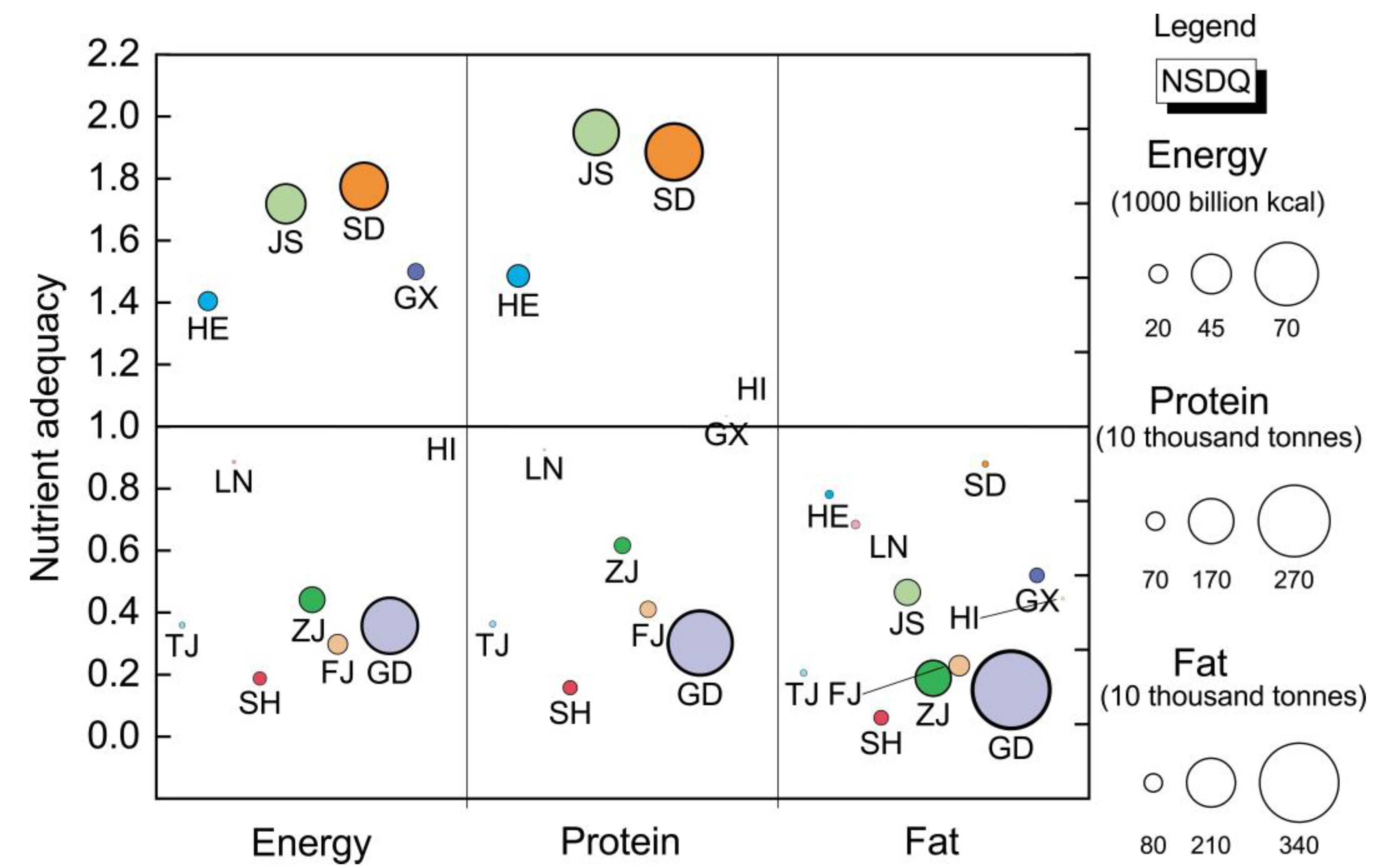Spatial Differences of Nutrient Adequacy in Coastal Areas of China
Abstract
1. Introduction
2. Data and Methods
2.1. Research Areas
2.2. Transformation Model of Nutrient Production
2.3. Transformation Model of Nutrient Consumption
2.4. Nutrient Adequacy
2.5. Data
3. Results
3.1. Nutrient Production in Coastal Areas of China
3.2. Nutrient Consumption in Coastal Areas of China
3.3. Spatial Differences of Nutrient Adequacy in Coastal Areas of China
4. Discussion
5. Conclusions
Author Contributions
Funding
Data Availability Statement
Conflicts of Interest
References
- FAO; IFAD; UNICEF; WFP; WHO. The State of Food Security and Nutrition in the World 2020; FAO: Rome, Italy, 2020. [Google Scholar]
- Singh, B.K.; Arnold, T.; Biermayr-Jenzano, P.; Broerse, J.; Brunori, G.; Caron, P.; Schutter, O.D.; Fan, S.; Fanzo, J.; Fraser, E.; et al. Enhancing science—Policy interfaces for food systems transformation. Nat. Food 2021, 2, 838–842. [Google Scholar] [CrossRef]
- Simelane, K.S.; Worth, S. Food and nutrition security theory. Food Nutr. Bull. 2020, 41, 367–379. [Google Scholar] [CrossRef] [PubMed]
- UN. Transforming Our World: The 2030 Agenda for Sustainable Development; UN: New York, NY, USA, 2015. [Google Scholar]
- FAO; IFAD; UNICEF; WFP; WHO. The State of Food Security and Nutrition in the World 2021; FAO: Rome, Italy, 2021. [Google Scholar]
- FAO; IFAD; UNICEF; WFP; WHO. The State of Food Security and Nutrition in the World 2022; FAO: Rome, Italy, 2022. [Google Scholar]
- Fan, S.; Rue, C. Achieving food and nutrition security under rapid transformation in China and India: A synthesis. China Agric. Econ. Rev. 2015, 7, 530–540. [Google Scholar] [CrossRef]
- Lu, Y.; Zhang, Y.; Hong, Y.; He, L.; Chen, Y. Experiences and lessons from Agri-Food system transformation for sustainable food security: A review of China’s practices. Foods 2022, 11, 137. [Google Scholar] [CrossRef]
- Martínez, M.L.; Intralawan, A.; Vázquez, G.; Pérez-Maqueo, O.; Sutton, P.; Landgrave, R. The coasts of our world: Ecological, economic and social importance. Ecol. Econ. 2007, 63, 254–272. [Google Scholar] [CrossRef]
- Hou, B.; Yue, W.Z.; Ma, R.F.; Wang, T.F.; Jia, Y.X. Research on the challenges and realization path of sea-land coordination in territorial spatial planning. J. Nat. Resour. 2022, 37, 880–894. [Google Scholar] [CrossRef]
- Yin, W.; Yu, H.J.; Yang, Y.D.; Xu, J.; Han, L.M. Pattern and coupling coordination evolution of land-marine food production capacity in coastal areas of China. Econ. Geogr. 2022, 42, 11–22. [Google Scholar]
- He, C.; Liu, Z.; Xu, M.; Ma, Q.; Dou, Y. Urban expansion brought stress to food security in China: Evidence from decreased cropland net primary productivity. Sci. Total Environ. 2017, 576, 660–670. [Google Scholar] [CrossRef]
- Liu, Y.; Zhou, Y. Reflections on China’s food security and land use policy under rapid urbanization. Land Use Policy 2021, 109, 105699. [Google Scholar] [CrossRef]
- Qi, X.; Wang, R.Y.; Li, J.; Zhang, T.; Liu, L.; He, Y. Ensuring food security with lower environmental costs under intensive agricultural land use patterns: A case study from China. J. Environ. Manag. 2018, 213, 329–340. [Google Scholar] [CrossRef]
- Van Wesenbeeck, C.F.A.; Keyzer, M.A.; van Veen, W.C.M.; Qiu, H. Can China’s overuse of fertilizer be reduced without threatening food security and farm incomes? Agric. Syst. 2021, 190, 103093. [Google Scholar] [CrossRef]
- Hawkins, J.; Ma, C.; Schilizzi, S.; Zhang, F. China’s changing diet and its impacts on greenhouse gas emissions: An index decomposition analysis. Aust. J. Agric. Resour. Econ. 2018, 62, 45–64. [Google Scholar] [CrossRef]
- Lei, L.; Shimokawa, S. Promoting dietary guidelines and environmental sustainability in China. China Econ. Rev. 2020, 59, 101087. [Google Scholar] [CrossRef]
- Yue, T.X.; Wang, Q.; Lu, Y.M.; Xin, X.P.; Zhang, H.B.; Wu, S.X. Change trends of food provisions in China. Glob. Planet. Change 2010, 72, 118–130. [Google Scholar] [CrossRef]
- Xin, L.J. Dietary structure upgrade of China’s residents, international trade and food security. J. Nat. Resour. 2021, 36, 1469–1480. [Google Scholar] [CrossRef]
- Pu, M.Z.; Zhou, L.; Zhong, Y.; Chen, M.S. Setting bottom lines for grain self-sufficiency in the grain production-and-consuming-balancing areas and major grain-consuming areas in China. Issues Agric. Econ. 2022, 511, 113–123. [Google Scholar]
- Zhou, Z. Achieving food security in China: Past three decades and beyond. China Agric. Econ. Rev. 2010, 2, 251–275. [Google Scholar] [CrossRef]
- Lam, H.M.; Remais, J.; Fung, M.C.; Xu, L.; Sun, S.S.M. Food supply and food safety issues in China. Lancet 2013, 381, 2044–2053. [Google Scholar] [CrossRef]
- Li, Y.; Zhang, W.; Ma, L.; Wu, L.; Shen, J.; Davies, W.J.; Oenema, O.; Zhang, F.; Dou, Z. An analysis of China’s grain production: Looking back and looking forward. Food Energy Secur. 2014, 3, 19–32. [Google Scholar] [CrossRef]
- Zhang, Y.; Zhang, H.; Yang, X. Changes in capacity of China’s agriculture to feed its population. Curr. Sci. 2018, 114, 280–291. [Google Scholar] [CrossRef]
- Zhang, D.; Wang, H.; Lou, S.; Zhong, S. Research on grain production efficiency in China’s main grain producing areas from the perspective of financial support. PLoS ONE 2021, 16, e247610. [Google Scholar] [CrossRef] [PubMed]
- Zhang, Q.; Zhang, F.; Wu, G.; Mai, Q. Spatial spillover effects of grain production efficiency in China: Measurement and scope. J. Clean. Prod. 2021, 278, 121062. [Google Scholar] [CrossRef]
- Lv, F.; Deng, L.; Zhang, Z.; Wang, Z.; Wu, Q.; Qiao, J. Multiscale analysis of factors affecting food security in China, 1980–2017. Environ. Sci. Pollut. Res. 2022, 29, 6511–6525. [Google Scholar] [CrossRef]
- Liu, X.; Xu, Y.; Engel, B.A.; Sun, S.; Zhao, X.; Wu, P.; Wang, Y. The impact of urbanization and aging on food security in developing countries: The view from Northwest China. J. Clean. Prod. 2021, 292, 126067. [Google Scholar] [CrossRef]
- Chen, K.; Bi, J.Y.; Nie, F.Y.; Fang, X.M.; Fan, S.G. New Vision and Policy Recommendations for Nutrition-Oriented Food Security in China. Sci. Agric. Sin. 2019, 52, 3097–3107. [Google Scholar]
- Fan, S.; Yosef, S.; Pandya-Lorch, R. Linking agriculture to nutrition: The evolution of policy. China Agric. Econ. Rev. 2020, 12, 595–604. [Google Scholar] [CrossRef]
- Yue, W.; Hao, H.U.; Wuyang, H.U. Agricultural production structure, market conditions and farmers’ nutritional intake in rural China. J. Integr. Agric. 2022, 21, 1812–1824. [Google Scholar] [CrossRef]
- Liu, A.; Han, A.; Chai, L. Assessing the Nutrient Adequacy in China’s Food Supply from 1965 to 2018. Nutrients 2021, 13, 2734. [Google Scholar] [CrossRef]
- Mekonnen, D.A.; Trijsburg, L.; Achterbosch, T.; Brouwer, I.D.; Kennedy, G.; Linderhof, V.; Ruben, R.; Talsma, E.F. Food consumption patterns, nutrient adequacy, and the food systems in Nigeria. Agric. Food Econ. 2021, 9, 16. [Google Scholar] [CrossRef]
- Costello, C.; Cao, L.; Gelcich, S.; Cisneros-Mata, M.Á.; Free, C.M.; Froehlich, H.E.; Golden, C.D.; Ishimura, G.; Maier, J.; Macadam-Somer, I.; et al. The future of food from the sea. Nature 2020, 588, 95–100. [Google Scholar] [CrossRef]
- Angeles-Agdeppa, I.; Custodio, M.R.S. Food sources and nutrient intakes of Filipino working adults. Nutrients 2020, 12, 1009. [Google Scholar] [CrossRef] [PubMed]
- Lei, L.I.; Zhai, S.; Bai, J. The dynamic impact of income and income distribution on food consumption among adults in rural China. J. Integr. Agric. 2021, 20, 330–342. [Google Scholar] [CrossRef]
- Xue, L.; Liu, X.; Lu, S.; Cheng, G.; Hu, Y.; Liu, J.; Dou, Z.; Cheng, S.; Liu, G. China’s food loss and waste embodies increasing environmental impacts. Nat. Food 2021, 2, 519–528. [Google Scholar] [CrossRef]
- FAO. The State of Food and Agriculture 2019—Moving Forward on Food Loss and Waste Reduction; FAO: Rome, Italy, 2019; pp. 2–13. [Google Scholar]
- Yin, W.; Yu, H.J.; Qiu, R.S.; Han, L.M. Food and nutrition security in China from the perspective of land-ocean coordination. Resour. Sci. 2022, 44, 674–686. [Google Scholar] [CrossRef]
- Koizumi, T. The Contribution of Agricultural Investments to Food Loss and the World Rice Market in Asian Countries. Jpn. Agric. Res. Q. JARQ 2018, 52, 181–196. [Google Scholar] [CrossRef]
- Yin, L.J.; Wang, L.X.; Liu, A.M. Regional Production and Consumption Equilibrium of Feed Grain in China and Its Policy Implication. J. Nat. Resour. 2018, 33, 965–977. [Google Scholar]
- Zhang, W.L. Feed Formulation and Quality Analysis; Beijing Institute of Technology Press: Beijing, China, 2014. [Google Scholar]
- Jia, M.; Zhen, L.; Xiao, Y. Changing Food Consumption and Nutrition Intake in Kazakhstan. Nutrients 2022, 14, 326. [Google Scholar] [CrossRef]
- Yuan, M.; Seale, J.L., Jr.; Wahl, T.; Bai, J. The changing dietary patterns and health issues in China. China Agric. Econ. Rev. 2018, 11, 143–159. [Google Scholar] [CrossRef]
- Pan, F.; Zhong, T.W.; Mao, W.F.; Liang, D.; Luan, D.C.; Su, C.; Li, J.W. Eating out of home of urban adults in eighteen provinces (autonomous regions, municipalities) of China in 2017. J. Hyg. Res. 2022, 51, 397–402+427. [Google Scholar]
- Bai, J.; Zhang, C.; Wahl, T.; Seale Jr, J. Dining out, the missing food consumption in China. Appl. Econ. Lett. 2016, 23, 1084–1087. [Google Scholar] [CrossRef]
- Xie, K.; Ding, M.; Zhang, J.; Chen, L. Trends towards Coordination between Grain Production and Economic Development in China. Agriculture 2021, 11, 975. [Google Scholar] [CrossRef]
- Sun, Y.; Chang, Y.; Liu, J.; Ge, X.; Liu, G.J.; Chen, F. Spatial differentiation of non-grain production on cultivated land and its driving factors in coastal China. Sustainability 2021, 13, 13064. [Google Scholar] [CrossRef]
- Abate, M.C.; Kuang, Y. The impact of the supply of farmland, level of agricultural mechanisation, and supply of rural labour on grain yields in China. Stud. Agric. Econ. 2021, 123, 33–42. [Google Scholar]
- El Bilali, H. Research on agro-food sustainability transitions: Where are food security and nutrition? Food Secur. 2019, 11, 559–577. [Google Scholar] [CrossRef]
- Ruben, R.; Cavatassi, R.; Lipper, L.; Smaling, E.; Winters, P. Towards food systems transformation—Five paradigm shifts for healthy, inclusive and sustainable food systems. Food Secur. 2021, 13, 1423–1430. [Google Scholar] [CrossRef]
- El Bilali, H.; Callenius, C.; Strassner, C.; Probst, L. Food and nutrition security and sustainability transitions in food systems. Food Energy Secur. 2019, 8, e00154. [Google Scholar] [CrossRef]
- Zhang, K.; Feng, T.Z.; Xiong, C.; Zhang, Z. Top design and progress in research and development of synthesis technique for reduction and synergy of chemical fertilizers and pesticides in China. Acta Phytophylacica Sin. 2019, 46, 943–953. [Google Scholar]
- Song, Y.; Wang, Y.; Jin, L.; Shi, W.; Aryal, J.; Comber, A. Quantitative contribution of the Grain for Green project to vegetation greening and its spatiotemporal variation across the Chinese Loess Plateau. Land Degrad. Dev. 2022, 33, 1878–1891. [Google Scholar] [CrossRef]
- Li, C.; Bremer, P.; Harder, M.K.; Lee, M.S.; Parker, K.; Gaugler, E.C.; Mirosa, M. A systematic review of food loss and waste in China: Quantity, impacts and mediators. J. Environ. Manag. 2022, 303, 114092. [Google Scholar] [CrossRef]
- Wang, L.; Wang, H.; Zhang, B.; Popkin, B.M.; Du, S. Elevated fat intake increases body weight and the risk of overweight and obesity among Chinese adults: 1991–2015 trends. Nutrients 2020, 12, 3272. [Google Scholar] [CrossRef]
- Fan, S.; Brzeska, J. Feeding More People on an Increasingly Fragile Planet: China’s Food and Nutrition Security in a National and Global Context. J. Integr. Agric. 2014, 13, 1193–1205. [Google Scholar] [CrossRef]
- Ingram, J. A food systems approach to researching food security and its interactions with global environmental change. Food Secur. 2011, 3, 417–431. [Google Scholar] [CrossRef]
- Guo, J.; Mao, K.; Yuan, Z.; Qin, Z.; Xu, T.; Bateni, S.M.; Zhao, Y.; Ye, C. Global food security assessment during 1961–2019. Sustainability 2021, 13, 14005. [Google Scholar] [CrossRef]
- Liu, Y.; Liu, J.; Zhou, Y. Spatio-temporal patterns of rural poverty in China and targeted poverty alleviation strategies. J. Rural Stud. 2017, 52, 66–75. [Google Scholar] [CrossRef]
- Wan, G.; Hu, X.; Liu, W. China’s poverty reduction miracle and relative poverty: Focusing on the roles of growth and inequality. China Econ. Rev. 2021, 68, 101643. [Google Scholar] [CrossRef]
- Gephart, J.A.; Henriksson, P.J.G.; Parker, R.W.R.; Shepon, A.; Gorospe, K.D.; Bergman, K.; Eshel, G.; Golden, C.D.; Halpern, B.S.; Hornborg, S.; et al. Environmental performance of blue foods. Nature 2021, 597, 360–365. [Google Scholar] [CrossRef] [PubMed]
- Tigchelaar, M.; Leape, J.; Micheli, F.; Allison, E.H.; Basurto, X.; Bennett, A.; Bush, S.R.; Cao, L.; Cheung, W.W.L.; Crona, B.; et al. The vital roles of blue foods in the global food system. Global Food Secur. 2022, 33, 100637. [Google Scholar] [CrossRef]
- Yu, J.; Yin, W.; Liu, D. Evolution of mariculture policies in China: Experience and challenge. Mar. Policy 2020, 119, 104062. [Google Scholar] [CrossRef]
- Yu, H.; Wang, Y.; Yin, W.; Li, D. Policy network analysis of China’s ocean ranching policy: Network structure, actors and interaction. Mar. Policy 2022, 140, 105070. [Google Scholar] [CrossRef]



| Area | Energy (1000 Billion Kcal) | Protein (10 Thousand Tonnes) | Fat (10 Thousand Tonnes) | |||||||
|---|---|---|---|---|---|---|---|---|---|---|
| Sea Food | Land Food | Total | Sea Food | Land Food | Total | Sea Food | Land Food | Total | ||
| Tianjin | TJ | 0.03 | 3.91 | 3.94 | 0.43 | 13.69 | 14.12 | 0.08 | 8.01 | 8.09 |
| Hebei | HE | 0.23 | 75.30 | 75.54 | 4.04 | 263.70 | 267.73 | 0.46 | 133.47 | 133.93 |
| Liaoning | LN | 1.42 | 29.83 | 31.25 | 20.46 | 79.61 | 100.08 | 2.63 | 80.69 | 83.32 |
| Shanghai | SH | 0.01 | 3.55 | 3.56 | 0.12 | 10.33 | 10.45 | 0.02 | 4.36 | 4.38 |
| Jiangsu | JS | 0.65 | 109.19 | 109.84 | 9.77 | 350.37 | 360.14 | 1.51 | 99.91 | 101.43 |
| Zhejiang | ZJ | 2.41 | 21.00 | 23.41 | 36.92 | 65.48 | 102.40 | 7.10 | 29.59 | 36.69 |
| Fujian | FJ | 3.55 | 6.08 | 9.63 | 43.78 | 0.33 | 44.11 | 8.31 | 19.16 | 27.47 |
| Shandong | SD | 2.96 | 122.43 | 125.39 | 42.05 | 428.25 | 470.30 | 6.67 | 198.63 | 205.31 |
| Guangdong | GD | 2.44 | 33.67 | 36.12 | 33.67 | 74.68 | 108.35 | 5.99 | 55.05 | 61.05 |
| Guangxi | GX | 0.97 | 55.84 | 56.81 | 12.96 | 116.39 | 129.35 | 2.31 | 68.76 | 71.07 |
| Hainan | HI | 0.84 | 5.51 | 6.36 | 13.86 | 13.73 | 27.59 | 2.36 | 9.25 | 11.61 |
| Nutrients/Area 1 | TJ | HE | LN | SH | JS | ZJ | FJ | SD | GD | GX | HI |
|---|---|---|---|---|---|---|---|---|---|---|---|
| Energy (kcal) | 2156 | 1995 | 2248 | 2100 | 2084 | 2331 | 2172 | 1929 | 2265 | 2108 | 1814 |
| Protein (g) | 76 | 67 | 69 | 73 | 60 | 73 | 72 | 68 | 81 | 70 | 66 |
| Fat (g) | 77 | 63 | 78 | 79 | 71 | 86 | 80 | 64 | 91 | 76 | 73 |
Publisher’s Note: MDPI stays neutral with regard to jurisdictional claims in published maps and institutional affiliations. |
© 2022 by the authors. Licensee MDPI, Basel, Switzerland. This article is an open access article distributed under the terms and conditions of the Creative Commons Attribution (CC BY) license (https://creativecommons.org/licenses/by/4.0/).
Share and Cite
Yin, W.; Yu, H.; Wang, Y.; Qiu, R.; Han, L. Spatial Differences of Nutrient Adequacy in Coastal Areas of China. Nutrients 2022, 14, 4763. https://doi.org/10.3390/nu14224763
Yin W, Yu H, Wang Y, Qiu R, Han L. Spatial Differences of Nutrient Adequacy in Coastal Areas of China. Nutrients. 2022; 14(22):4763. https://doi.org/10.3390/nu14224763
Chicago/Turabian StyleYin, Wei, Huijuan Yu, Yecheng Wang, Rongshan Qiu, and Limin Han. 2022. "Spatial Differences of Nutrient Adequacy in Coastal Areas of China" Nutrients 14, no. 22: 4763. https://doi.org/10.3390/nu14224763
APA StyleYin, W., Yu, H., Wang, Y., Qiu, R., & Han, L. (2022). Spatial Differences of Nutrient Adequacy in Coastal Areas of China. Nutrients, 14(22), 4763. https://doi.org/10.3390/nu14224763







